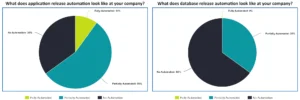The DevOps movement has revolutionized software delivery, emphasizing collaboration, automation, and continuous improvement. Application releases are increasingly streamlined, with many companies achieving full or partial automation. However, a new report from DBmaestro and devops.com reveals a critical gap in this process – database releases are lagging far behind. This blog post dives into the findings of the webinar, “Database DevOps: Automate, Collaborate, Deliver and Win,” highlighting the importance of database DevOps and the risks associated with neglecting it.
The State of Application vs. Database Release Automation
The DBmaestro and devops.com webinar surveyed attendees on their current application and database release practices. The results paint a clear picture:
For the question “What does application release automation look like at your company?” responses were as follows:
Application Release Automation:
10% – Fully Automated
55% – Partially Automated
35% – No Automation
For the question “What does database release automation look like at your company?” responses were as follows:
Database Release Automation:
0% – Fully Automated
35% – Partially Automated
65% – No Automation
These findings reveal a significant disparity. While over half (55%) of the surveyed companies have embraced some form of application release automation, a staggering 65% haven’t adopted any automation for their databases. This disconnect creates a bottleneck in the DevOps pipeline, potentially hindering the speed and efficiency of software delivery.
Why Database Automation Matters
Databases are the backbone of modern applications, storing critical data that fuels operations. The manual release of database changes, however, is a risky and time-consuming process. Here’s why database automation is essential:
- Reduced Errors: Manual processes are prone to human error. Scripting and automating database deployments can significantly minimize these errors, ensuring consistent and reliable updates.
- Improved Speed and Efficiency: Automation eliminates the need for manual intervention, streamlining deployments and expediting software releases. This allows developers and DBAs to focus on more strategic tasks.
- Enhanced Consistency: Database automation ensures that deployments are executed exactly the same way every time. This eliminates inconsistencies that can lead to unexpected issues.
- Reduced Downtime: Manual deployments often require downtime for database updates. Automation allows for faster and more seamless transitions, minimizing disruptions to users.
- Improved Collaboration: Automating database deployments fosters better collaboration between development and database teams. Version control and clear documentation streamline handoffs and troubleshooting.
The Cost of Manual Database Releases
Leaving databases out of the DevOps loop doesn’t just impact efficiency; it can also have a significant financial cost. Gartner research indicates that system downtime can cost businesses an average of $9,000 per minute. Manual deployments create a higher risk of downtime due to human error and complex, time-consuming processes.
Building a Bridge: Integrating Database DevOps
The findings of the DBmaestro webinar highlight the need for a shift in mindset. Here’s how organizations can bridge the gap between application and database automation:
- Embrace Database DevOps Principles: Integrate the database into your DevOps pipeline. This means adopting tools and practices that automate database deployments, testing, and configuration management.
- Invest in Database Automation Tools: Utilize tools specifically designed for automating database changes. These tools can streamline script management, schema changes, and deployments.
- Promote Collaboration: Foster closer collaboration between development and database teams. Shared ownership of the entire delivery pipeline, including the database, is crucial for success.
- Start Small, Scale Up: Begin by automating smaller, less critical database deployments. This allows teams to gain experience and confidence before tackling more complex changes.
Conclusion: A DevOps Win for Everyone
By embracing database automation, organizations can unlock the full potential of DevOps. Automating database releases leads to faster deployments, reduced errors, and improved collaboration between development and database teams. The benefits extend beyond streamlined workflows; they translate to cost savings and a more reliable, efficient software delivery pipeline. Take a step towards true DevOps success – automate your database releases and see the wins for yourself.






